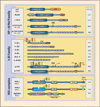Regulation of NF-κB by TNF family cytokines
- PMID: 24958609
- PMCID: PMC4156877
- DOI: 10.1016/j.smim.2014.05.004
Regulation of NF-κB by TNF family cytokines
Abstract
The NF-κB family of inducible transcription factors is activated in response to a variety of stimuli. Amongst the best-characterized inducers of NF-κB are members of the TNF family of cytokines. Research on NF-κB and TNF have been tightly intertwined for more than 25 years. Perhaps the most compelling examples of the interconnectedness of NF-κB and the TNF have come from analysis of knock-out mice that are unable to activate NF-κB. Such mice die embryonically, however, deletion of TNF or TNFR1 can rescue the lethality thereby illustrating the important role of NF-κB as the key regulator of transcriptional responses to TNF. The physiological connections between NF-κB and TNF cytokines are numerous and best explored in articles focusing on a single TNF family member. Instead, in this review, we explore general mechanisms of TNF cytokine signaling, with a focus on the upstream signaling events leading to activation of the so-called canonical and noncanonical NF-κB pathways by TNFR1 and CD40, respectively.
Keywords: CD40; IKK; Inflammation; NF-kappaB; Signaling; TNF.
Copyright © 2014 Elsevier Ltd. All rights reserved.
Figures



References
Publication types
MeSH terms
Substances
Grants and funding
LinkOut - more resources
Full Text Sources
Other Literature Sources
Research Materials

